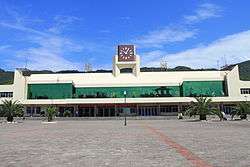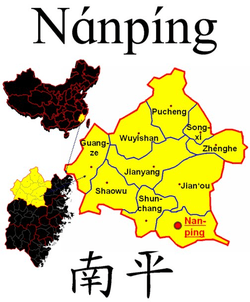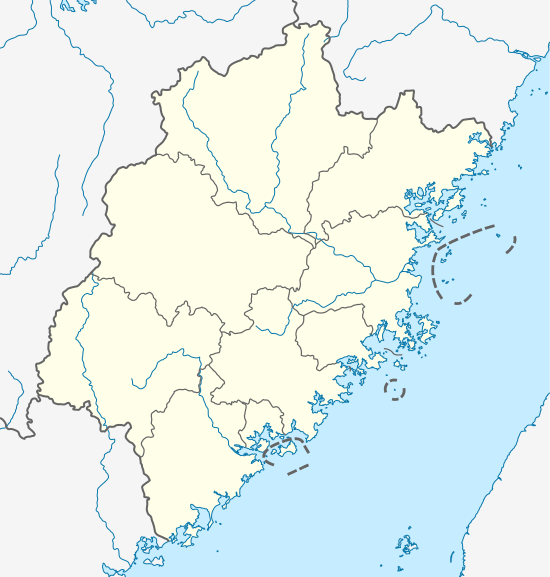Jian'ou
Jian'ou is a county-level city in Nanping in northern Fujian province, China. Under the name Jianning, it was formerly the seat of its own prefecture and was the namesake of its province.
Jian'ou is within a major bamboo and rice-growing area on Jianxi Brook, about 70 kilometres (43 mi) south from Jianyang.
The Jian'ou dialect, a dialect of Northern Min, is spoken in Jian'ou.
History

Jian'ou was formerly called Kenō. Later it became known as Jianning or Jianningfu from its role as the seat of Jianning Prefecture. This prefecture, along with Fuzhou, were the earliest-established Chinese territories in the area and thus their province bears their conjoined names: Fu + Jian. Jianning was once the capital of Fujian and also served as the capital of the kingdom of Yin in AD 943.[1] Jian'ou was visited by Marco Polo in 1291 on his way from Hangzhou to Quanzhou. In his Travels, dictated seven years later to a scribe writing in Old French, the name Jianning-fu is romanised as Quenlinfu.[2][3] The city is, he says,
"of considerable size, and contains three very handsome bridges, upwards of a hundred paces in length and eight paces in width. The men of the place are very handsome, and live in a state of luxurious ease. There is much raw silk produced here and it is manufactured into silk pieces of various sorts. Cottons are also woven of coloured threads, which are carried for sale to every part of the province of Mangi.[lower-alpha 1] The people employ themselves extensively, and export quantities of ginger and galangal. I have been told, but did not myself see the animal, that there are found at this place a species of domestic fowls which have no feathers, their skins being clothed with black hair, resembling the fur of cats. Such a sight must be extraordinary. They lay eggs like other fowls, and they are good to eat. The multitude of tigers renders traveling through the country dangerous, unless a number of persons go in company."[4]
Under the Yuan Dynasty, the name was changed from Jianning-Fu to Jianning-Lu. This was a result of an administrative restructuring: formerly, Jian'ou was the capital of the local fu, or prefecture. Jian'ou was made the capital of the local lu, a collection of prefectures still smaller than a province, and was renamed Jianning-Lu accordingly.[5]
Administration
4 Subdistricts
Ouning Street Office (瓯宁街道): Qilijie Village, Shuixi Village
Zhishan Street Office (芝山街道): Xida Village, Haodong Village, Mawen Village
Jian'an Street Office (建安街道): Dong'an Village, Dongmen Village, Qianjie Community
Tongji Street Office (通济街道): Sanmen Village, Nanmen Village, Dongxi Village, Qiaonan Community, Nanmen Community, Taozhu Community
10 Towns
Xudun (徐墩镇): Datan Village, Jiukuang Village, Lingtou Village, Hutang Village, Shanbian Village, Xiadui Village, Fengle Village, Fudun Village, Beijin Village, Dongbian Village, Guizong Village, Yefang Village, Changting Village, Xudun Village, Wanshou Community
Jiyang (吉阳镇): Guili Village, Julikou Village, Huangfu Village, Dafu Village, Qiaoxi Village, Zhangkeng Village, Shengli Village, Xinqiao Village, Caodun Village, Zhaidun Village, Yuxi Village, Jiyang Village
Fangdao (房道镇)
Dongyou (东游镇)
Xiaoqiao (小桥镇)
Yushan (玉山镇)
Nanya (南雅镇): Fangcun Village
Dikou (迪口镇)
Xiaosong (小松镇)
Dongfeng (东峰镇)
4 Townships
Chuanshi (川石乡)
Shunyang (顺阳乡)
Shuiyuan (水源乡)
Longcun (龙村乡)
Transportation
- Railway: Hengfeng–Nanping Railway, Hefei-Fuzhou High-Speed Railway
- Highway: G205, G25 Changchun-Shenzhen Expressway, G3 Beijing–Taipei Expressway
- Coach Station: Jian'ou Station
Specialty
Notable people
Scenic
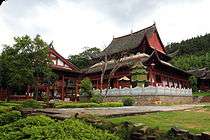
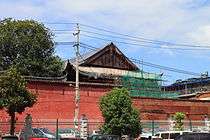
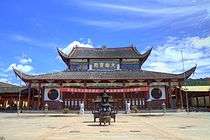
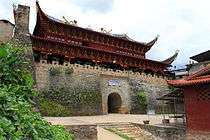
Climate
| Climate data for Jian'ou (1981−2010) | |||||||||||||
|---|---|---|---|---|---|---|---|---|---|---|---|---|---|
| Month | Jan | Feb | Mar | Apr | May | Jun | Jul | Aug | Sep | Oct | Nov | Dec | Year |
| Record high °C (°F) | 28.8 (83.8) |
32.4 (90.3) |
33.8 (92.8) |
35.3 (95.5) |
37.3 (99.1) |
38.0 (100.4) |
41.7 (107.1) |
41.7 (107.1) |
39.1 (102.4) |
37.1 (98.8) |
33.2 (91.8) |
27.9 (82.2) |
41.7 (107.1) |
| Average high °C (°F) | 14.0 (57.2) |
15.7 (60.3) |
19.1 (66.4) |
24.6 (76.3) |
28.4 (83.1) |
31.1 (88) |
34.8 (94.6) |
34.4 (93.9) |
31.2 (88.2) |
26.9 (80.4) |
21.4 (70.5) |
16.1 (61) |
24.8 (76.7) |
| Daily mean °C (°F) | 8.7 (47.7) |
10.7 (51.3) |
13.9 (57) |
19.0 (66.2) |
22.9 (73.2) |
25.9 (78.6) |
28.6 (83.5) |
28.0 (82.4) |
25.3 (77.5) |
20.7 (69.3) |
15.1 (59.2) |
9.8 (49.6) |
19.1 (66.3) |
| Average low °C (°F) | 5.2 (41.4) |
7.4 (45.3) |
10.5 (50.9) |
15.2 (59.4) |
19.1 (66.4) |
22.2 (72) |
24.1 (75.4) |
23.8 (74.8) |
21.4 (70.5) |
16.5 (61.7) |
11.1 (52) |
5.7 (42.3) |
15.2 (59.3) |
| Record low °C (°F) | −5.0 (23) |
−4.0 (24.8) |
−3.2 (26.2) |
3.7 (38.7) |
9.5 (49.1) |
13.7 (56.7) |
19.9 (67.8) |
18.0 (64.4) |
12.8 (55) |
4.0 (39.2) |
−1.8 (28.8) |
−7.2 (19) |
−7.2 (19) |
| Average precipitation mm (inches) | 71.2 (2.803) |
116.6 (4.591) |
205.6 (8.094) |
216.6 (8.528) |
238.1 (9.374) |
303.1 (11.933) |
121.6 (4.787) |
133.2 (5.244) |
98.6 (3.882) |
59.9 (2.358) |
58.7 (2.311) |
50.4 (1.984) |
1,673.6 (65.889) |
| Average relative humidity (%) | 82 | 83 | 83 | 81 | 81 | 82 | 77 | 78 | 79 | 79 | 81 | 81 | 81 |
| Source: China Meteorological Data Service Center | |||||||||||||
Notes
- ↑ Usually anglicised as Manji, the Chinese term Manzi (蛮子, meaning roughly Barbary) was the name north of the Yangzi for the lands south of it, lands now comprising the rump (or Southern) Song Dynasty centred at Hangzhou. Enduringly based in the north, the Mongols completed their conquest of the rump Song in 1279, annexing it in its entirety and reducing Hangzhou to one provincial capital among many in their vast Yuan Empire. The Yuan Emperor of course was Polo's nominal host for nearly two decades. For more on the term, cf. Names of China.
References
- ↑ "The historical evolution of Jian'ou city / 建瓯市建制沿革" (in Chinese). Official website of Jian'ou government. 2017-05-02. Retrieved 2018-07-06.
- ↑ Polo, Marco (1997), Marsden, William, ed., Make Poluo Lvji, Hertfordshire: Wordsworth Editions .
- ↑ Polo, Marco (1997), Yang Zhijiu, ed., Make Poluo Lvji, Beijing: Foreign Languages College Research Publishing, p. 18 .
- ↑ Polo, Marco, Travels of Marco Polo, ch. LXXIV, pp.199-200.
- ↑ "An 800-year-old label may rewrite the history of a Java Sea shipwreck". Ars Technica. Retrieved 2018-07-20.
- ↑ "Li Qiumei - the sports star of Northern Min" (in Simplified Chinese). Nanping Sports Bureau. 2010-07-14.
